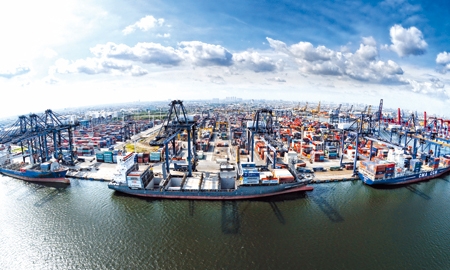Announced in May 2011, the government’s Master Plan for the Acceleration and Expansion of Indonesia’s Economic Development (MP3EI) aims to propel the country into the world’s top 10 economies and raise GDP per capita income from $3,000 to $15,000 by 2025. The plan is underpinned by three main pillars: the creation of six distinctive economic corridors; improving human resources as well as boosting science and technology; and thirdly, enhancing connectivity both domestically and across the ASEAN region, with a major push for increased transport and infrastructure.
Comprising more than 17,500 islands, Indonesia is the world’s largest archipelago. At a crossroad of global routes, some 70 per cent of the world’s sea trade passes through Indonesian waters. Furthermore, as 70 per cent of its territory is made up of water, maritime connectivity and infrastructure is key to ensuring economic growth is as evenly spread as possible.
Indonesia’s higher ranking in the 2014 Logistics Performance Index issued by the World Bank recognises the ongoing improvements being achieved in its logistics sector. Overall Indonesia rose to 53rd place, compared to its 59th spot in the previous edition of 2012. The most notable gains were made
in infrastructure, logistics competence and customs.
Nevertheless, logistical costs remain high in Indonesia. According to the Indonesian Logistics Association (ALI), they make up some 25 to 30 per cent of GDP, whereas by comparison in Thailand they are 16 per cent, and in Singapore even lower, at 10 per cent.
The Ministry of Trans-portation is investing billions of pounds into improving and developing the country’s ports over the next several years. Major works at the country’s busiest one, Tanjung Priok in Jakarta, could potentially lower the logistical costs to just 12 per cent of GDP, according to Richard Joost Lino, President Director of the state-owned
Indonesia Port Corporation (
IPC).
Three new container terminals will be built at nearby Kalibaru Port, with the first one expected to begin operations in mid-2015. In late April, IPC chose Matsui of Japan to operate the terminal through a joint venture. Some $2.5 billion will be spent on the new terminals, which when finished by 2018, will add 6 million TEUs to Tanjung Priok’s capacity, virtually doubling it.
Work on a new car terminal at the port will turn it into the fifth largest in the world. “We are expanding the capacity from 250,000 units to 750,000 units,” says Mr Lino.
Another way IPC proposes to reduce sea freight costs is through the Pendulum Nusantara (‘Pendulum of the Archipelago’) project. Also known as the ‘East-West Pendulum’, the idea is to develop a special sea corridor connecting the six main ports of Belawan, Batam, Tanjung Priok, Surabaya, Makasar and Sorong through several loops.
“For instance the Port of Sorong is connected through the loop of North Maluku and North Sulawesi,” says Mr Lino. “You can unite the country with this pendulum service. For example from Jakarta to Sorong the average shipping costs [before the fuel subsidy cuts were] $2,000. By using the pendulum service you can reduce the costs considerably by 80 per cent.”
Pendulum Nusantara is now in even greater demand since the Indonesian government announced the end of fuel subsidies last year in June, driving prices up by an average of 33 per cent. Another subsidy drop is expected this year; however, despite these unpopular moves that save the government billions a
year, the country still has some of the lowest fuel prices in the world.
Meanwhile, Indonesia’s logistics industry is growing at an annual rate of 15 to 20 per cent, helped by increasing consumption levels and the uptake of online shopping needing to be delivered.
The Indonesian Logistics Association has collaborated with the government to draft a logistic blueprint for the country. According to former ALI President, Zaldy Ilham Masita, the blueprint established the necessary rules and regulations and standardises the industry and the investments needed.
“We expect that the National Logistics Blueprint will not only be the guidance for ministries on where they should build infrastructure, but also improve the costs of logistics,” he says.
High demand for logistics services looks set to continue and operators believe investors should get involved sooner rather than later. “I think that anybody who comes in with the right mind set and partners with the right person will see a very quick growth,” says Frank Findlow, Country Manager of Linfox Logistics Indonesia.
Although the logistics sector was the second biggest target for FDI in 2012 after mining, there is much work to be done. Johari Zein, Managing Director of
JNE, believes greater foreign partnerships would ameliorate logistics and deliveries across the archipelago. “I think the country should be more open to foreign investors, especially when it comes to them bringing quality and technology at the moment,” he says, adding that the government should “provide certification for local players, so they can reach a certain level when it comes to quality and so they can benchmark themselves against international standards.”
JNE is a local delivery company that has grown steadily and organically, providing quality services by offering faster delivery and fewer risks when it comes to shipments for its customers.
The company can provide express shipments from Europe to Indonesia, offering a next-day delivery service to Jakarta and the day after to the rest of the country.
Like many Indonesian logistics firms, JNE partners with another company – in this case, UPS – to deliver international shipments. In general, the market is characterised by many local players outsourcing important links in their supply chain management and distribution to third-party logistics providers – not all of which are foreign. Companies like Cardig Logistics, Kamadjaja Logistics, Samudera Shipping and Puninar Logistics are all local firms engaged in third-party logistics. And, with thousands of small and medium sized players in the sector, pricing competition is tough.

0 COMMENTS